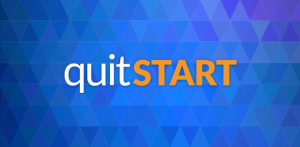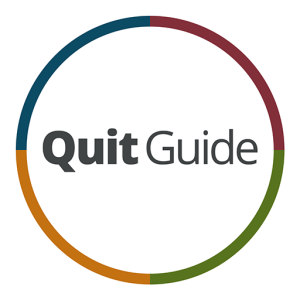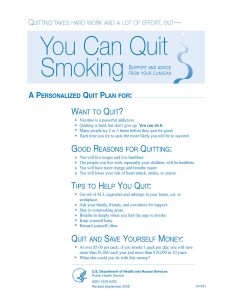You can quit! Learn more about the benefits of quitting smoking, strategies to quit, medications, Penn State Health Tobacco Cessation programs and research studies you can join.
Jump to topic
Search
Getting ready to quit
Why quit?

- Live longer
- Be healthier
- Breathe easier
- Have more energy
- Lower your risk of heart attacks, strokes and cancers
- Save time and money
- Free yourself from addiction
- Stop exposing family to second-hand smoke
Stopping smoking is generally the single best thing a smoker can do to improve their health.
Quitting Smoking Will Save You a Lot of Money
This calculator from Smokefree.gov will show you exactly how much money you’ll save. A 1-pack-per-day smoker who spends $9 per pack will save $3,285 per year or $49,182 over 10 years with average price increases.
Savings can be used to purchase nicotine replacement while you quit and then to celebrate your newfound freedom from smoking. In addition, most premiums for health insurance and life insurance are lower for non-smokers, as are out-of-pocket medical costs.
Annual deaths from smoking in the United States
More than 480,000 U.S. deaths each year are from smoking.
Note: Average annual number of deaths for adults aged 35 or older, 2005-2009.
Source: CDC.gov/2014 Surgeon General’s Report.
Health Effects of Smoking
Smoking causes illnesses affecting almost every part of the body and can result in an average of 10 years of life lost due to health conditions.
Tobacco use, second-hand smoke and environmental smoke greatly increase the risk of:
- Heart disease and circulation problems (smokers are up to three times more likely to die of a heart attack than non-smokers)
- Stroke or brain aneurysm
- Cancer (smokers are 20 times more likely to develop lung cancer)
- Respiratory infections and asthma
- Chronic lung diseases such as emphysema and COPD in adults (smokers are 15 times more likely to develop chronic breathing problems)
- Miscarriage, stillbirth, prematurity and low birth weight
Tobacco use also:
- Reduces the senses of taste and smell
- Makes wrinkles worse and reduces softness of skin
- Is a major cause of erectile dysfunction
- Causes teeth discoloration
- Gives clothes, hair, breath, car and home an odor that others often find offensive
- Sends an unhealthy message to kids
- Can affect the health of your family and pets by second-hand smoke
Smoking compared with other risk factors
A man in his 40s with high blood pressure and high cholesterol who is also a smoker has a 29 percent chance of having a heart attack in the next 10 years. This means that for every three of these patients, statistically one would have a heart attack within 10 years.
- With normal blood pressure only, that risk falls to 21 percent.
- With normal cholesterol only, the risk is 19 percent.
- By quitting smoking only, the risk drops to 9 percent.
- By quitting smoking and lowering blood pressure and cholesterol, the risk is only 3 percent.
Stopping smoking has a bigger effect than the other two risk factors (high blood pressure and high cholesterol) combined, and it also reduces the risks of other conditions such as cancer, chronic obstructive pulmonary disease (COPD) and stroke.
Quitting Smoking Will Save You a Lot of Money
This calculator from Smokefree.gov will show you exactly how much money you’ll save. A 1-pack-per-day smoker who spends $9 per pack will save $3,285 per year or $49,182 over 10 years with average price increases.
Savings can be used to purchase nicotine replacement while you quit and then to celebrate your newfound freedom from smoking. In addition, most premiums for health insurance and life insurance are lower for non-smokers, as are out-of-pocket medical costs.
S.T.A.R.T. Getting Ready to Quit
- Set a Quit Date (no more than 2-4 weeks in advance)
- Tell your friends and family and ask for their support. Make sure they don’t offer you even 1 cigarette.
- Anticipate challenges and use your notes from this sheet to overcome them.
- Remove tobacco from your life (home, car, pockets, etc.)
- Talk to your doctor to learn about medications that can help you quit smoking for good.
The American Cancer Society and the National Cancer Institute’s Smokefree.gov have free tools to help you make your own customized quit plan.
It is important to plan ahead, particularly if you plan to cut down the amount you smoke prior to your quit date. Additionally, some medications should be started before your planned quit date.
Relapse Triggers and Coping Strategies
- Get rid of all cigarettes, lighters, ashtrays and other objects that are cues for using tobacco products. Check car, pockets, etc.
- Avoid alcohol (at least for the first month) as it may trigger a desire to smoke.
- Develop new ways to manage stress, such as going for a walk or calling a friend.
- Avoid places where you usually purchase or use tobacco products.
- Ask others not to offer you tobacco products or use them around you.
- Establish friendships with people who don’t use tobacco and avoid those that do.
- Avoid smoke breaks and other situations where you usually use tobacco.
- Develop a plan for how to deal with cravings before they happen.
- Learn from previous attempts; think about what worked and what didn’t.
- Make use of resources and medications.
- Start your quit attempt with friends or family who also want to quit.
- Commit to the quit attempt: don’t smoke even 1 cigarette.
Adapted from CDC’s A Practical Guide to Help Your Patients Quit Using Tobacco.
Managing Cravings (5 D’s)
- Delay. Most urges pass after a few minutes, so if you tell yourself you won’t smoke for the next ten minutes, chances are the urge will pass.
- Distract. When you get an urge, try not to think about smoking. Have a plan for what you will do, whether it be to take a walk, call a friend, read a book, watch TV or exercise.
- Drink water. It’s a healthy way to deal with cravings.
- Deep breaths. Taking slow, deep breaths helps you to relax—and may be one of the reasons why you felt relaxed while smoking. Inhale through your nose and breathe out through your mouth.
- Discuss. Talk to someone about how you’re feeling. If you have somebody quitting with you, they can offer you additional support. Quitline and your doctor are also good resources for dealing with cravings.
Resources to Help You Quit Smoking or Vaping
Pennsylvania Quitline
- 1-800-QUIT-NOW (784-8669)
- Spanish: 1-855-DEJELO-YA (335-3569)
- Also available via text, chat, email or online.
- PA Quitline will provide up to five free coaching calls to help formulate a quit plan and free nicotine replacement therapy (NRT) for those medically eligible. Its website can be used to help formulate a quit plan. Text or email support will send you motivational, informational, coaching messages.
- Available 7 days a week, and 37% of patients who use Quitline and nicotine replacement therapy are able to quit smoking
- Pregnant patients eligible for additional coaching, NRT and financial incentives.
- Special programs for youths (tobacco and vaping) and Native Americans
Asian Smokers Quitline
The Asian Smokers Quitline provides tobacco cessation counseling and NRT in Cantonese, Mandarin, Vietnamese, and Korean.
- 1-800-838-8917 (Mandarin and Cantonese)
- 1-800-556-5564 (Korean)
- 1-800-778-8440 (Vietnamese)
My Life, My Quit Youth Tobacco and Vaping Cessation Program
- Call 1-855-891-9989
- Text 36072
- Visit pa.mylifemyquit.org
The My Life, My Quit program is a free and confidential service for teens who want help quitting all forms of tobacco including vaping with tobacco treatment specialists trained on adolescent cognitive and psychosocial development.
Coaches use motivational interviewing and cognitive-behavioral techniques to help teens:
- Develop a quit plan.
- Identify triggers for tobacco use.
- Practice refusal skills.
- Obtain ongoing support for changing behaviors.
Teens who participate in the program receive:
- Five, one-on-one coaching sessions usually scheduled every 7-10 days. Coaching helps teens develop a quit plan, identify triggers, practice refusal skills and receive ongoing support for changing behaviors.
- Self-help and educational materials designed for teens, with input from teens.
- Additional support by phone, by text message or by online chat.
My Life, My Quit Youth Tobacco and Vaping Cessation Program
The My Life, My Quit program is a free and confidential service for teens who want help quitting all forms of tobacco including vaping with tobacco treatment specialists trained on adolescent cognitive and psychosocial development.
Coaches use motivational interviewing and cognitive-behavioral techniques to help teens:
- Develop a quit plan.
- Identify triggers for tobacco use.
- Practice refusal skills.
- Obtain ongoing support for changing behaviors.
Teens who participate in the program receive:
- Five, one-on-one coaching sessions usually scheduled every 7-10 days. Coaching helps teens develop a quit plan, identify triggers, practice refusal skills and receive ongoing support for changing behaviors.
- Self-help and educational materials designed for teens, with input from teens.
- Additional support by phone, by text message or by online chat.
The My Life, My Quit Youth Tobacco and Vaping Cessation program has a website designed for parents with information on youth vaping and how they can talk to their teens about smoking/vaping and help them quit. The My Life, My Quit website has resources for parents in English and Spanish.
Penn State Health Tobacco Cessation Guide
This brochure will help you list reasons why you want to quit and identify your support system. It also includes tips for creating your quit plan, managing cravings and where to get help.
Help for Smokers and Other Tobacco Users
This short guide offers tips for getting ready to quit. (Agency for Healthcare Research and Quality)
Agency for Healthcare Research and Quality Worksheets
This worksheet will help you identify barriers to and resources you can utilize to help you quit. A version of this worksheet is also available specifically for expecting mothers. Versions en español of the standard and expecting mother worksheet are available. Find links to all versions in both web and PDF formats here.
University of Wisconsin
The University of Wisconsin Center for Tobacco Research and Intervention includes video tips from smokers on quitting, information on medications that can help you quit, and links to other websites to help you quit, including resources specifically for veterans, teenagers, pregnant women and Native Americans, or help affording your medications.
Penn State Health Tobacco Cessation Clinic
Penn State Health has a designated tobacco cessation clinic within Penn State Cancer Institute. No referral is required, and appointments can be made by calling the number on the website. Most health insurance will cover two quit attempts per year each consisting of up to four visits. Penn State Health can provide counseling, help you to form a quit plan and prescribe medications to help you quit if medically appropriate.
Penn State Cancer Institute Care Center Tobacco Cessation
Patients with an active cancer diagnosis may be eligible for tobacco cessation through Penn State Cancer Institute Care Center. Patients can talk with their Penn State cancer doctor and request a referral to the Care Center.
Penn State Health Primary Care Providers
Penn State Health primary care providers are trained to help you stop smoking and can prescribe tobacco cessation medications when medically appropriate. Follow this link to find a doctor within the Penn State Health system.
Penn State Health Employees
Penn State Health employees can take advantage of the Employee Tobacco Intervention Program. This free program can be accessed through employee health.
Penn State Employees
Penn State employees can access the university’s free tobacco cessation program.
Penn State students
Penn State students can access the free Freshstart® Program through University Health Services.
Medications
There are seven medications that are FDA-approved to help you quit smoking. These include two non-nicotine medications that are pills: Varenicline (Chantix) and Bupropion (Wellbutrin/Zyban) as well as the five nicotine replacement (NRT) options: patches, gum, inhaler, lozenge and nasal spray. Although medications can be expensive, they are always cheaper than buying cigarettes. There are also programs such as Quitline that can provide free nicotine replacement therapy to help you start your quit attempt.
If using nicotine replacement therapy (NRT), be sure you are using the correct dosage. Follow directions on medication package unless otherwise directed by your doctor. View sample dosing schedules for the different medication types from the UW Center for Tobacco Research and Intervention.
The American Cancer Society has information on both prescription medications and over-the-counter nicotine replacement therapy, in addition to instructions on how to make a quit plan and staying tobacco free after you quit.
The University of Wisconsin Center for Tobacco Research and Intervention has excellent information for those interested in quitting smoking or stopping e-cigarettes and covers the seven FDA approved medications for tobacco cessation, including how they work and common side effects.
Paying for your medications
If you have concerns about affording your medications, including medications to help you quit smoking, there are resources available to help. In addition to PA Quitline, which provides a limited supply of free Nicotine Replacement Therapy when medically indicated, the University of Wisconsin Center for Tobacco Research and Intervention has a list of other resources to help you afford your medications. Your doctor can also help you access programs or connect you with a social worker at Penn State Health who can help you get the medications you need.
American Cancer Society
The American Cancer Society has information on how to make a quit plan, ways to quit with and without medications, and staying tobacco free after you quit. They also have a free Empowered to Quit program, which is an email-based program designed to help you quit.
Smokefree.gov
The National Cancer Institute’s Smokefree.gov:
- Contains information on starting a quit attempt, creating your quit plan, using nicotine replacement therapy, managing cravings, sustaining your quit attempt and the benefits of quitting.
- Contains specific sites for veterans, pregnant women, teenagers, seniors and Spanish speakers.
- Ability to chat live with a tobacco cessation counselor
- Text-to-Quit and apps available
- Site created by the National Cancer Institute
University of Wisconsin Center for Tobacco Research and Intervention
The University of Wisconsin Center for Tobacco Research and Intervention has a selection of hand-outs on the seven FDA approved medications for tobacco cessation, tools for creating a quit plan, dealing with cravings, a tobacco use log and more.
American Lung Association
American Lung Association’s Freedom From Smoking Online Curriculum:
- Includes free, interactive, self-directed web-based curriculum
- Reports a 60% success rate for those who complete the program and use cessation medication(s)
My Life, My Quit
The My Life, My Quit Youth Tobacco and Vaping Cessation program has resources to help teens learn how to quit tobacco and vaping including confidential coaching, flyers, and text/chat support.
Youth Smoking and Vaping: Websites For Parents
The My Life, My Quit Youth Tobacco and Vaping Cessation program has a website designed for parents with information on youth vaping and how they can talk to their teens about smoking/vaping and help them quit. The My Life, My Quit website for parents has resources in English and Spanish.
National Cancer Institute
National Cancer Institute’s Smokefree.gov
- Offers a live chat option to those on the site.
PA Quitline
- Offers live chat to learn about counseling and medication options.
National Cancer Institute QuitGuide and quitSTART apps
These free apps can help you learn how to quit and sustain your attempt. quitSTART can even send you a reminder or tip at a specific time or when you go to a specific location you’ve identified as a high risk for relapse.
 The quitSTART app helps you:
The quitSTART app helps you:
- Get ready to quit with tips and information to prepare you for becoming smokefree
- Monitor your progress and earn badges for smokefree milestones and other achievements
- Get back on track if you slip and smoke
- Manage cravings and bad moods in healthy ways
- Distract yourself from cravings with games and challenges
- Store helpful tips, inspirations and challenges in your Quit Kit Share your progress and favorite tips through social media
 QuitGuide helps you:
QuitGuide helps you:
- Track cravings and slips by times of day and location
- Track your mood and smoking triggers
- Stay motivated with inspirational messages Identify your reasons for quitting
- Get tips and distractions for dealing with cravings and bad moods
- Monitor your progress toward achieving smokefree milestones
- Create journal entries
National Cancer Institute
The National Cancer Institute’s Smokefree.gov text-to-quit service offers special programs for veterans, pregnant women, teenagers, seniors and Spanish speakers as well as programs for e-cigarettes. This text-to-quit program will send daily text messages for 6 to 8 weeks to support you in your quit attempt.
You can learn more about the programs or sign-up for specific programs here or by texting the following:
- Smokers (adults and teens): Text QUIT to 47848
- En español: Text ESP al 47848
- Pregnant women: Text MOM to 222888
- Veterans: Text VET to 47848
- Veterans en español: Text VETESP al 47848
- Dip: Text SPIT to 222888
PA Quitline
PA Quitline offers a text-to-quit service that will send motivational, informational, coaching text messages or emails.
My Life, My Quit Youth Tobacco and Vaping Cessation Program
Text: 36072
Preventative Care for Tobacco Users
The United States Preventative Health Task Force recommends patients who use tobacco products receive preventative care including pneumococcal pneumonia vaccination and lung cancer screening depending on their tobacco exposure. Talk to your primary care doctor to find out if you are eligible.
Penn State Tobacco Cessation Clinical Trials
Click here for a list of active Penn State Center for Research on Tobacco and Health clinical trials you may be eligible to participate in investigating nicotine, smoking, and health. Studies may be available both for patients interested in quitting smoking and those who are not yet ready to quit.

